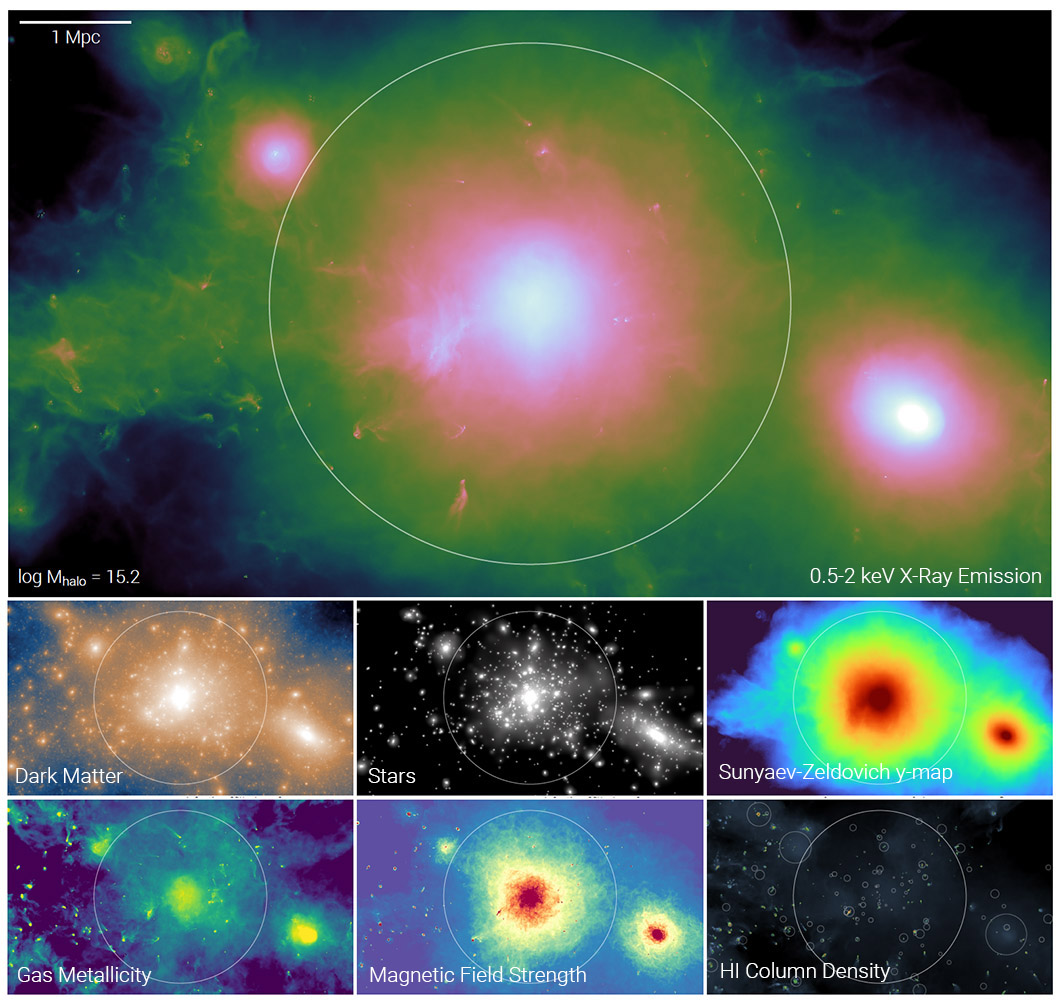TNG-Cluster: cosmological simulations of the most massive objects in the Universe
Project ID: TNG-Cluster
Introduction
TNG-Cluster is a cosmological magnetohydrodynamical simulation of cosmic structure formation, from shortly after the Big Bang until the present day. It self-consistently solves the coupled equations of self-gravity and MHD within an expanding spacetime. It simulates several hundred galaxy clusters – the most massive gravitationally bound objects in the Universe, each with a mass of roughly 10^15 times the mass of the Sun. TNG-Cluster resolves the multi-scale interplay of astrophysics processes, from gas cooling and turbulence, to star formation, stellar evolution, supernovae explosions, to the formation of supermassive black holes and their powerful feedback energetics. It is a broad theoretical model that enables us to probe the (astro)physics of galaxy clusters.
| Principal investigator: | Dr. Dylan Nelson Dr. Annalisa Pillepich |
| Project manager: | Dr. Dylan Nelson Dr. Annalisa Pillepich |
| Researchers: | Reza Ayromlou, Wonki Lee, Katrin Lehle, Eric Rohr, Nhut Truong |
| Date published: | November 2023 |
| HPC platform used: | HoreKa |
| Institute: | Institute of Theoretical Astrophysics Max-Planck-Institute for Astronomy |
| Affiliation: | Heidelberg University Max-Planck-Institute |
| Research field: | Physics |
| Project ID: | TNG-Cluster |
Figure: Visualization of the gaseous, stellar, and dark matter distribution and physical properties for the third most massive halo in TNG-Cluster at z=0, with a total M200c = 1015.2 solar masses. The main panel shows soft-band (0.5-2 keV) X-ray surface brightness. The smaller panels show dark matter density, stellar density, the Sunyaev-Zeldovich y-parameter map, gas-phase metallicity, magnetic field strength, and neutral HI column density. In this final panel, the location and size of the 100 most massive subhalos are also indicated with circles. In all cases, the white circle marks R200c.
Project description
Galaxy clusters are the ultimate outcome of the hierarchical assembly of structure. Their stellar bodies, supermassive black holes (SMBHs), dark matter halos, and gaseous atmospheres are all constructed from the collective merging of thousands, if not tens of thousands, of smaller constituents. Clusters are the most massive gravitationally bound structures in the Universe. They host the most massive galaxies, the most massive SMBHs, and the largest populations of satellite galaxies that exist. The dynamics and physical processes at play in the hot plasma of the intracluster medium (ICM) are complex, diverse, and observable. They are cosmologically rare, yet form a crucial observational probe of our cosmological model.
TNG-Cluster has three principal scientific goals:
- (i) to understand the gas physics of the intracluster medium,
- (ii) to provide the necessary observables for precision cosmology in the next decade,
- (iii) to explore the assembly of the most massive galaxies and their surrounding satellite galaxy populations.
By well-sampling these rare structures we have simulated a sizeable sample of massive clusters and galaxies. The excellent numerical resolution, combined with the rich features and physics of the TNG model, enables novel science.
In particular, we can study the interplay of galaxy interactions, SMBH feedback, turbulence, magnetic field amplification, non-thermal support, and shock formation and propagation in shaping the properties of the ICM of clusters. This is the gas that, having been heated to temperatures of 10 million Kelvin or more, fills massive dark matter halos and, in turn, affects the evolution of galaxies therein. For example, how do kinematic turbulence and SMBH-driven outflows influence the observable velocity structure of the ICM? How are the location, strength, and morphology of shock fronts regulated? What dominates the gas structure in the cluster core vs. its outskirts? How do the thermodynamical properties and kinematics of the ICM depend on the feedback from SMBHs? Do mergers between clusters change the picture?
TNG-Cluster enables us to develop mock observations of the ICM to compare against, and gain insights from, current and upcoming observations. These range from radio wavelengths from synchrotron emission, to the mm and X-ray bands. For the latter, two fundamental observables characterize galaxy clusters: the Sunyaev-Zelvodich effect, whereby photons from the cosmic microwave background interact with free electrons in the ICM plasma, and X-ray emission, primarily from thermal bremsstrahlung. In fact, X-ray detected clusters will play a key role in many precision cosmology experiments over the next decade. However, traditional cosmological pipelines suffer from an inadequate parameterization and marginalization over the key parameters of mass-observable relations. With TNG-Cluster, we can provide theoretically-motivated priors on the redshift evolution, shape, and intrinsic scatter of the relations between cluster mass and X-ray luminosity and temperature.
Finally, although only a few percent of all galaxies at the present day reside in the most massive and rarest dark-matter halos, these clusters contain a unique mixture of galaxy types. TNG-Cluster will provide an unmatched dataset for the theoretical study of brightest cluster galaxies (BCGs), satellite galaxies, as well as of proto-clusters at high redshifts. We can ask, for example, how do physical mechanisms such as mergers, star formation, gas accretion and SMBH feedback determine the mass and morphological evolution of BCGs? At what past epochs have they been disky and star forming? What causes galaxies shaped like flattened disks to transform into elliptical spheroids? What is the relationship between the BCG and cool-core clusters? How does the proto-cluster environment affect the evolution of galaxies that will become cluster galaxies?
More information, visualizations, movies, and references are available on the project website: www.tng-project./cluster

